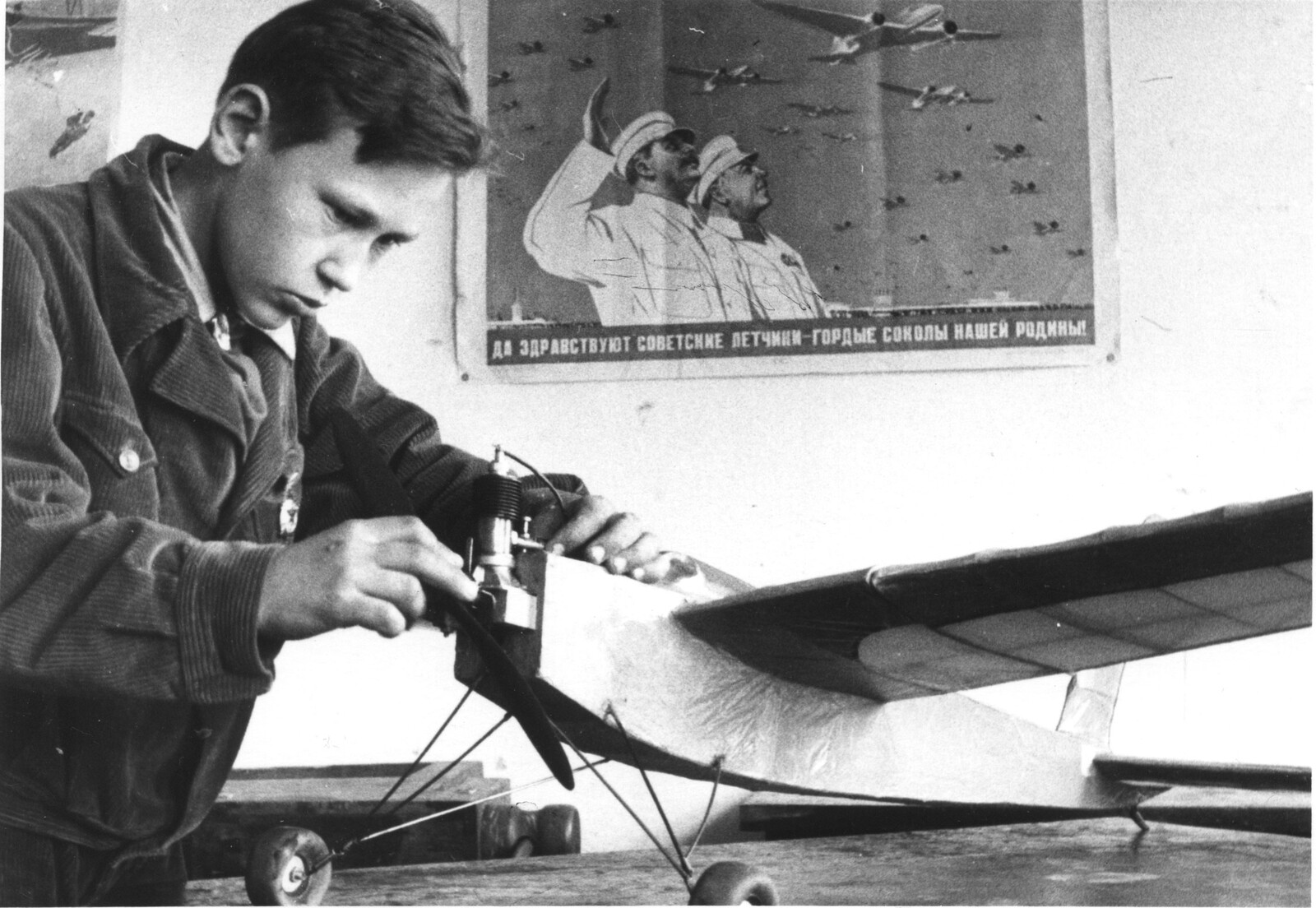In his 1937 review of a memoir by the aviator Georgii Baidukov, writer Andrei Platonov provides a richly speculative picture of Soviet socialism:
A symbolic image of the entire modern economy might be a heavy body, supported in air space by the thrust of a propeller; at one and the same time, this image gives a precise picture of the most intense work of the mechanism and of the person of our time.
But what kind of person is it who works on a machine in the air, on a machine that pulls behind it all of modern technology? Does the pilot-person not have some new features that will later be transferred to the character of the future person?1
Andrei Platonov’s “symbolic image” suggests that Soviet socialism can be kept aloft, defying gravity at least for the time being, as a precisely calculated interaction of mechanical energy and human labor. But there is, Platonov suggests, the possibility of a different economy, one yet to be defined, let alone achieved, where natural limitations like gravity, entropy, and perhaps even death will not have to be resisted so forcefully, where the flight of socialism will become effortless, free, and final. This would be communism, albeit in a version that owes as much to the cosmism of Nikolai Fedorov and Aleksandr Bogdanov as it does to Marx and Lenin.
Platonov’s eccentric vision of a cosmist communism has made him into one of the most intriguing and inspiring Soviet writers for our day, but this cosmic horizon was also available in mainstream Soviet discourse, and specifically in the popular cinema, albeit in softer, less conspicuous forms than the literal belief in the “resurrection of fathers,” the need to populate other planets, and the possibility of suspending the economy as a perpetuum mobile. Nowhere is this as evident as in the Soviet fascination with the scale model, a dialectical mode of representation that informed the Soviets’ broad optimism about what we today might call the Anthropocene, an optimism that now seems quaint, if not dangerous, but from which we still have much to learn.
1. From Mechanics to Energetics
Marxism is fundamentally cosmist, at least in its Soviet version. The most common quotation from Marx in Soviet discourse of the 1930s, really more a paraphrase, was that “by transforming nature, man transforms himself.”2 This dialectical understanding of nature was evident in Lenin’s 1920 slogan “communism = Soviet power + electrification of the entire land,” and it was boosted by the publication in 1925 of Friedrich Engels’s Dialectics of Nature. Stalin’s “transformation of nature,” beginning with the First Five-Year Plan in 1928, was expedient, opportunistic, and brutally cynical, especially in its murderous reliance on convict labor; but the Five-Year Plans also allowed cosmist-minded comrades like Platonov to continue to dream of an apocalyptic transubstantiation or, at the very least, a decisive leap into a different, freer state of nature.
One of the most authoritative statements of cosmist Marxism came in August 1931 when Nikolai Bukharin described an impending technological revolution, or “technological re-equipping of the entire land,” under the auspices of the Five-Year Plans. In an official report, Bukharin lays the greatest emphasis on the increased production of electricity, the automatization of production, and the acceleration of communications:
The old methods of organizing production are disappearing and are being replaced by the flow method with an automatic workbench, with the automatism of the entire process, with its division into a series of steps, coming one after the other, as on a cinematic film strip.3
This montage—as cinematic as it is industrial—is not merely the Taylorist fantasy of total efficiency, which was popular in the Soviet Union in the 1920s, particularly among the artistic avant-garde. Bukharin was also describing a world in which the laws of mechanics would be superseded by those of energetics, that is to say, a unified force field that at high levels of energy would defy the laws of classical physics.4
The leap into this new state of material being required not only new mechanisms, but also a new relation between consciousness and matter, and a new mode of labor:
The old methods of organizing labor are displaced by the use of psychotechnics [psikhotekhnika] and methods of employing [eksploatatsiia] the working class—tested in the laboratory, measured and scientifically thought through—with which the possible shortening of the work day and increase of wages are to the utmost degree compensated for by the heightened intensification of labor, by its unusual concentration [uplotnenie] and sharp rise of norms of employment.(312)
In order to keep communism aloft, in other words, the Soviet Union required not only “the convergence of theory and practice” (326) in a coordinated intensification of tempos of automatic and human labor. It also required “the transformation of the USSR into a single cultural whole on the technical basis of a developed communications system” (317), one that “must be much less verbal, ‘humanitarian’ in the old sense of this word, and … more ‘technological’” (319). It sounds almost as if Bukharin was calling for the psychotechnologies of avant-garde cinema to be realized as an economic system.
Although one version of it was published in Pravda, the Party leadership’s response to Bukharin’s 1931 report was uniformly negative. Stalin called it “an empty, non-Bolshevik report that is out of touch with real life.”5 Lazar’ Kaganovich accused Bukharin of “a schematic approach, mechanistic philosophy, and Bogdanovism [bogdanovshchina].”6 But although Bukharin’s presentation still betrayed the cosmist tendency towards magical thinking, some of the resources he named for the “convergence of theory and practice” (326) seem startlingly prosaic, local, and small scale: “technical museums … technical libraries, exhibitions, repositories of blueprints and diagrams, etc., etc.” (323–24). The schematization advocated by cosmism is not that of the metaphysical modernism of a Malevich, but rather that of the museum: displays of technical drawings, models of miniaturized mechanisms, etc. Common to all these modes of bridging theory and practice was the scale model, a central component in the “iconography of materialism,”7 and the dialectical object par excellence.
2. Marxist Model
The scale model is already present in the image from Platonov with which I began: the economy as an autonomous airborne motor. The model is at once a “symbolic image” that signifies powerfully in the present, an experimental object that initiates the achievement of the future, and a machine for transforming the subjectivities of those who labor on it.
Platonov evokes common images from the 1930s in the entire range of media of children working on scale models, transforming themselves as they produce new technologies on a small scale. In the above photograph from 1939, a smartly dressed boy works on a model airplane at a workbench, with aviation posters pinned to the wall behind him. The poster on the right, made in 1938 by Nina Vatolina and Nikolai Denisov, shows the white-suited Stalin and Kliment Voroshilov, commissar of defense and chief enthusiast of airplane modeling, saluting a formation of airсraft. It bears the slogan: “All Hail Soviet Pilots, the Proud Falcons of Our Homeland!” The poster plugs this provincial children’s workshop into the centralized structures and discourses of power; the boy is working with the intention of adding his own modest project to the already assembled ranks of aircraft, fashioning it as an object that ultimately will be beheld by the elevating gaze of Stalin and Voroshilov. As in Platonov’s image, this boy’s scale model exhibits categorical fluidity: it begins life as a toy, becomes a prototype, and potentially will end up in a museum exhibit about the genesis of a new inventor. In the virtuous cycle of the Soviet model, hands teach heads, which then, having become more intelligent, teach hands.
The Soviet fascination with models had deep roots in Marxist thought. In the very same passage of Capital that speaks about the mutual transformation of humans and the natural world, Marx highlights something akin to modeling as the distinguishing feature of human labor: “What distinguishes the worst architect from the best of bees is this, that the architect raises his structure in his imagination before he erects it in reality. At the end of every labour-process, we get a result that already existed in the imagination of the labourer at its commencement.”8
In a 1925 analysis, the young Soviet psychologist Lev Vygotskii elaborated on this process. Whereas the spider and bee act “on the strength of hereditary instinct, like a machine, always identically and without finding in this any more activity than in all other adaptive reactions,” humans are defined by their “doubling of experience”:
In hand movements and the changes of material labor repeats what has previously been done in the worker’s imagination [predstavlen’e] as if with models of these same movements and this same material. The animal lacks this very doubled experience, which allows man to develop forms of active adaptation.9
If the spider and the bee demonstrate “a passive adaptation to the environment,” then humans display “the active adaptation of the environment to oneself.”10 Humans by nature are cosmists.
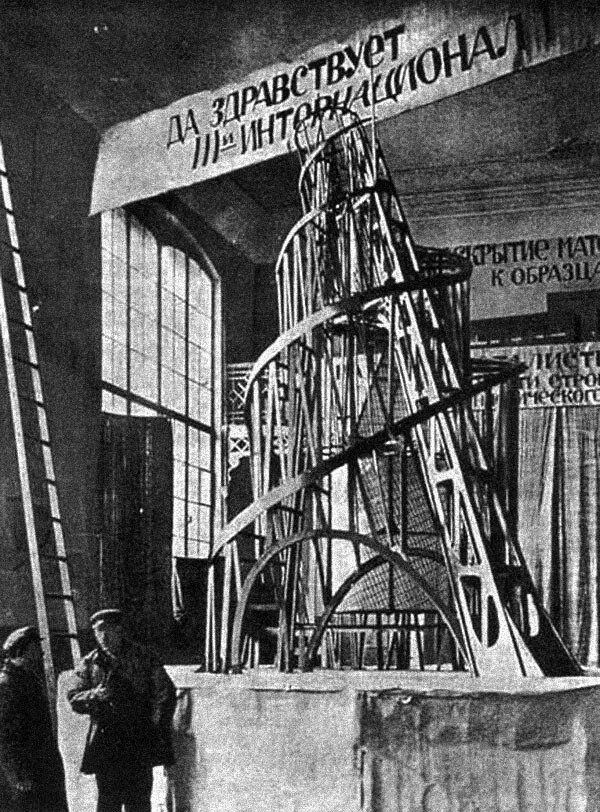

Vladimir Tatlin and collaborators alongside his Model for a Monument to the Third International (1920).
The Soviet theory of model labor in the 1930s owes its most direct debt to the constructivists, beginning with Tatlin’s Model for a Monument to the Third International, which encoded cosmist ideas on an anthropometric scale, evidently directed less at full-scale production than at the stimulation of further generations of models. Above the model, Tatlin and his team have hung a partially visible slogan that reads, hypothetically, “Through the revelation of material to exemplars of the new object.” Theorizing the logic of these models was the particular province of constructivist theorist Nikolai Chuzhak, who wrote in the first issue of LEF:
Accepting the auxiliary status of cognition, the working class is everywhere—both in real, actual science, and in real, actual art-making, and in real, talon-to-talon battle for the needed social structure—everywhere the proletariat is shifting the center of gravity from the moment of cognition to the direct construction of the thing, including the idea, but only as a specific engineerial model.11
Modeling was emphasized as an activity in the avant-garde curriculum of the Higher Artistic-Technical Workshops, or VKhUTEMAS, where designers modeled functional furniture under the instruction of constructivists Aleksandr Rodchenko and Varvara Stepanova, and where student architects were asked to produce material, three-dimensional models of abstract concepts like space and volume.
For Chuzhak, the model is an inevitable mode of art production for a materialist society oriented towards the future realization of its scientific ideas:
The construction of dialectical models of tomorrow—whether predominantly from an emotional angle (art) or a logical one (science)—is just as necessary for the class of the future as the construction of the object itself. And scientifically both kinds of creativity are equally justified by dialectical materialism. It is not difficult to see that the art of communist constructions will lean increasingly to the model.12
Chuzhak was right; the model quickly spread from the studios and workshops of the avant-garde to vocational classrooms and clubs. Under the First Five-Year Plan, the model ceased to be the exclusive province of the radical avant-garde, and by 1932 it had become a signal mode of aesthetic production under socialist realism.
Bukharin’s philosophical arguments in favor of scale modeling, both in theory and as a material practice, were gratefully noted by the authors of the 1932 book The Art of Modeling, D. Greitser and V. Bibikov, who underscore the dynamism of the model as an ontological category, as it passes from experimental object to production prototype and to “study device.” Greitser and Bibikov argue that, far from being merely a modest element in pedagogical practice, the model challenges the most basic notions of Soviet production and labor. Requiring individual initiative, the model cannot be planned. Requiring handicraft and intuition, it cannot be mass-produced. Once produced it cannot be commodified, since it is immediately superseded by a new and improved model. Its singularity and categorical fluidity make the Soviet model distinct from mere replicas: “The USSR of the reconstruction period cannot allow itself the luxury of building dead models,” write Greitser and Bibikov. “We need living models which awaken initiative and teach how to build.”13 The model not only makes representations of the future into concrete steps towards achieving it, but also initiates the transformation of labor into a new psychotechnological process. Models, then, are nothing less than machines for keeping communism aloft.
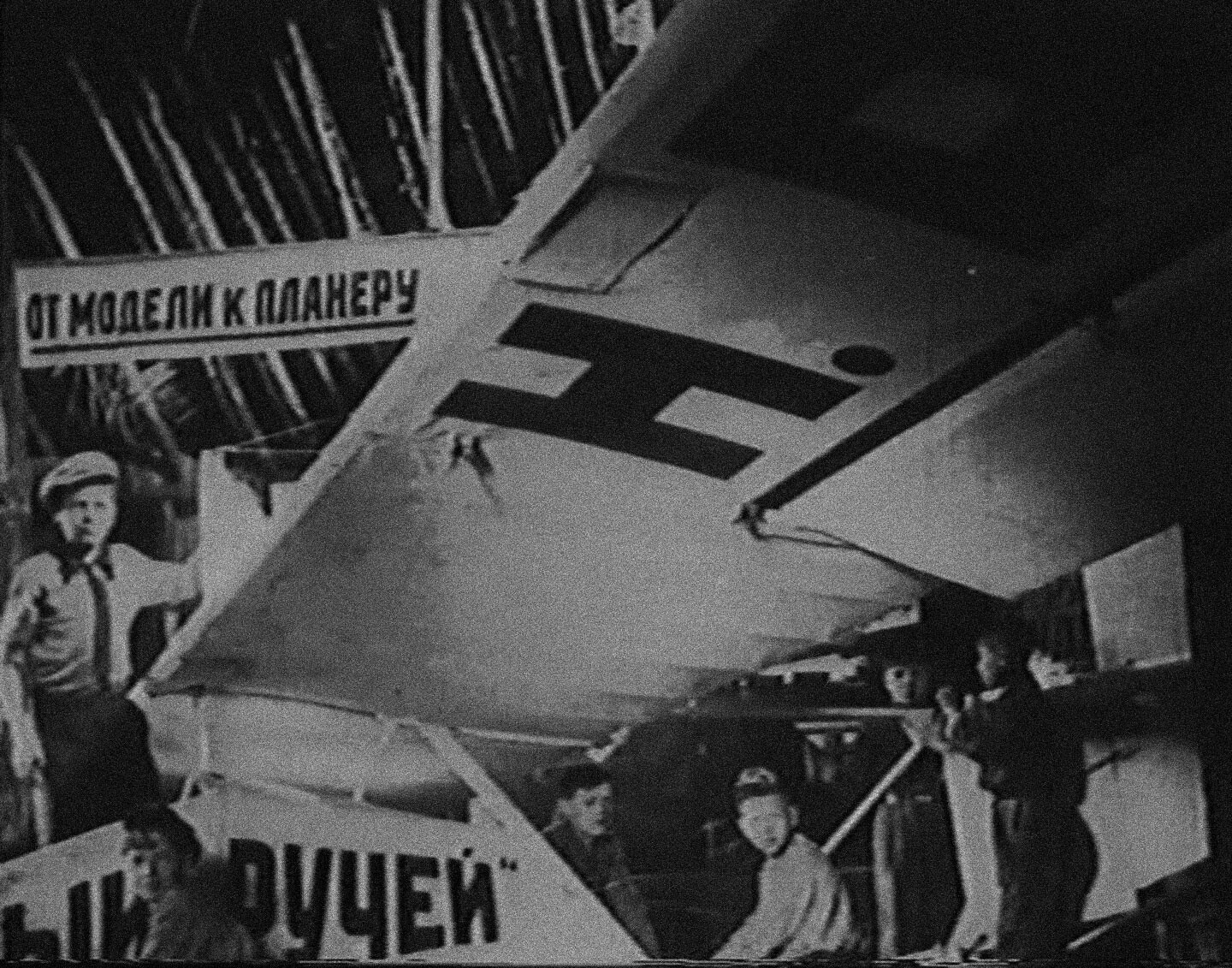

One Stop to the Moon (Na lunu s peresadkoi), dir. Nikolai Lebedev, 1934/39.
3. Model Constructivism, Model Cinema
In the 1930s, scale models proliferated in Soviet sound cinema, fulfilling a wide range of forms and functions. Dziga Vertov’s 1930 Symphony of the Donbass features a working model of the Five-Year Plan, recalling the VKhUTEMAS models of abstract constructive principles: this is a three-dimensional, working model of the future economy. A central scene in Nikolai Ekk’s 1931 Ticket to Life shows a commune of juvenile delinquents being converted to collective labor by playing with a model railway, emphasizing the model’s role as a machine for remaking the Soviet subject. The 1932 film Who Will I Be?, produced by a star-studded crew of former constructivists—Aleksandr Rodchenko, Vitalii Zhemchuzhnyi, Osip Brik, composer Arsenii Avraamov—demonstrated the fluid interchange between playing with scale models and labor on a full-size apparatus, united in the socialist production of non-fetishized objects. In putting the handmade, miniaturized model to work for the entire Soviet state, these films defy any firm distinction between documentary and fiction, history and fantasy. They help Soviet cinema to live up to Bukharin’s expectations, both in the establishment of a nationwide system of ideological communication and in the replacement of purely “humanitarian” discourse with “psychotechnics”: Soviet cinema becomes a soul machine.
The ability of Soviet cinema to function as a soul machine is at issue in the 1934 film One Stop to the Moon (Na lunu s peresadkoi), shot by Nikolai Lebedev and based on a screenplay by Leonid Panteleev. Kolkhoz whiz kid Lenia Glebov begins by building a model spaceship named The Earth-Moon Non-Stop Express in an abandoned windmill. Together with classmates he manages to shoot the Express out of the windmill, but it crashes into a nearby field, where it is discovered by the head of the local political section, who identifies the culprit thanks to a note from Lenia addressed to “comrade Lunatics.” Summoning Lenia to his office, the political boss instructs the boy to approach things more gradually: to begin with paper airplanes, with a view to learning eventually to construct a glider, before proceeding to real airplanes. The group reconvenes to build the glider, encouraged by Natasha, a woman pilot from Moscow and the sister of the head of the political section. After crashing, Lenia recovers from his injuries just in time to take the glider to a nationwide contest in Koktebel’ at Natasha’s invitation.
One Stop to the Moon establishes not only a conceptual dialectic between play and labor, toy and technology, but also a visual relay between the children and the posters and slogans that decorate the interiors. As they make their glider, the children look like Tatlin and his collaborators in their model workshop, surrounded by slogans based on Voroshilov’s 1933 order in support of modeling: “From the model to the glider, from the glider to the airplane.”14 Thus, though the film counsels caution, and though as a silent film in 1934 it demonstrates the lag of Soviet technology behind its ambitions, the technologies of flight and of representation present themselves as dialectical steps towards global socialism. Fêted as a departing hero, when he leaves the kolkhoz for Koktebel’ Lenia proclaims: “In one or two Five-Year Plans I will fly to the moon after all!”
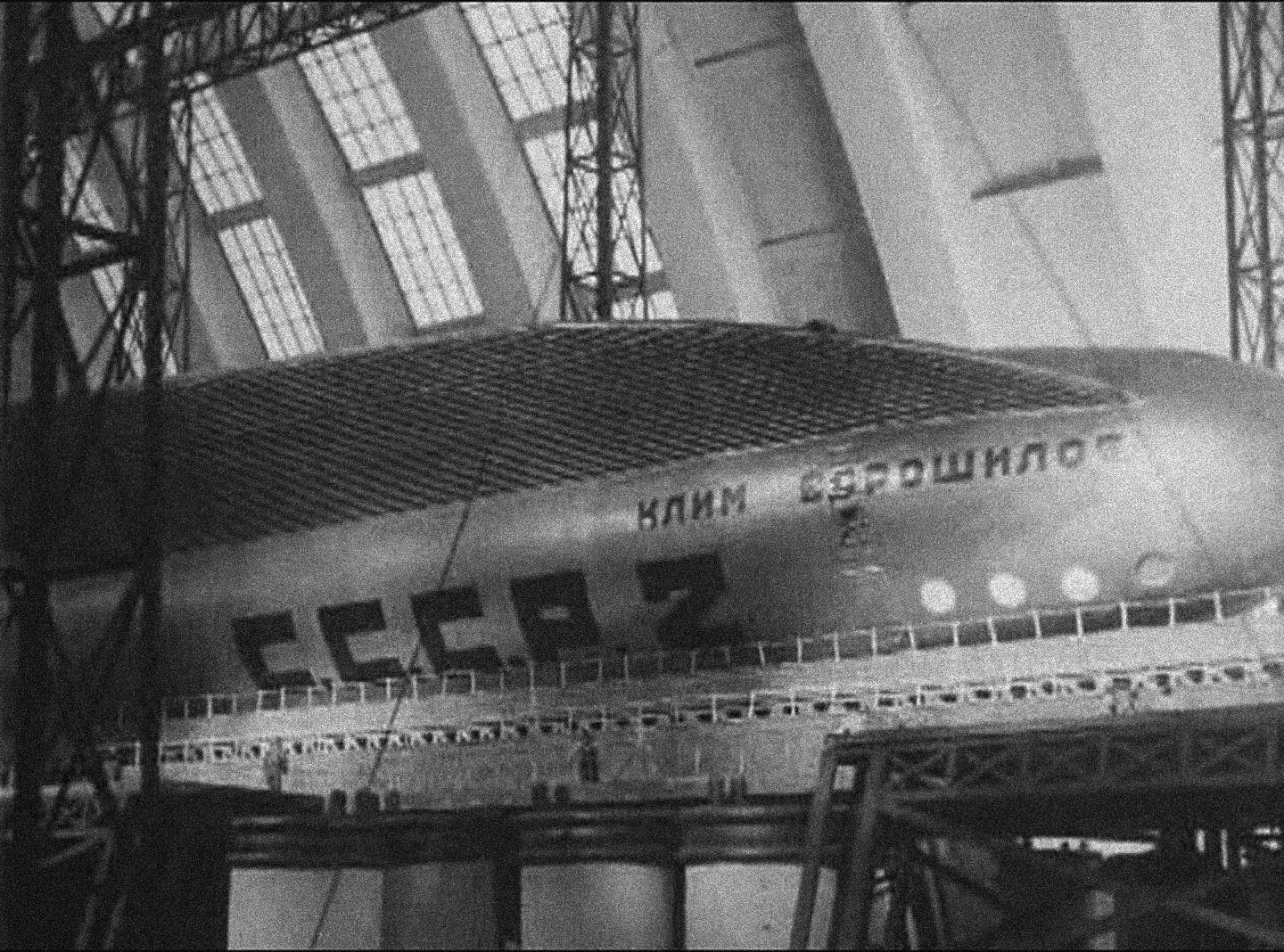

Cosmic Voyage (Kosmicheskii reis), dir. V. Zhuravlev, 1935.
4. The Cine-Model
The role of Soviet cinema was not only to broadcast model-thinking and model-making to far-flung populations; it also participated directly in modeling the new world that it was called to propagandize, most directly in miniaturized sets that allow for special effects. Special effects based on scale models make possible moving photographic documentation of worlds that have never and could never have existed.
In 1934, theorist Kornelii Zelinskii—a former constructivist—drew a direct analogy between models of experimental technologies and the functioning of the cinema under socialism. Naming three prominent examples from his time, Zelinskii asks, “How will our transport look, if Iarmol’chuk’s idea of a spherical train and spheremobile [sharopoezd, sharomobil’] wins out? Or Val’dner’s [idea of] the high-speed train?” Zelinskii then describes the task of socialist realist cinema as one of providing a “cine-model of our immediate future,” an attempt to “bring closer the look of communism to our eyes with the telescope of art.”15
The film that responded most emphatically to Kornelii Zelinskii’s call for a “cine-model of our immediate future” was The Cosmic Voyage (Kosmicheskii reis, 1935). Set in the “immediate future” of 1946, The Cosmic Voyage narrates the first manned mission to the moon by a venerable academic with similarities to rocket scientist and cosmist theorist Konstantin Tsiolkovsky, who in fact consulted on the film’s design and who approved its screenplay before his death in the year of the film’s release. Though The Cosmic Voyage was billed as a sound film, the soundtrack is wholly musical, and the actors follow conventions of silent cinema. And yet, despite its stylistic archaism, the film exhibits several features that make it into a powerful model not only for the “immediate future,” but also for a future cinema.
Most notably, the film’s spaceships bear distinct similarity to the experimental technologies that Zelinskii cites as analogies for his “cine-models”: Nikolai Iarmol’chuk’s spherical train or spheremobile, and Sevast’ian Val’dner’s high-speed train. As featured in the newsreel Science and Technology (Nauka i tekhnika), Iarmol’chuk developed a series of projects for a train on convex wheels running along a concave channel. In this newsreel, Iarmol’chuk displays a one-fifth scale model of his train, glistening in the sun. Around the same time, Val’dner projected a monorail aerotrain, driven by propellers, a one-tenth scale model of which was exhibited at Gorky Park from 1933 to 1936.16 Like these real experimental vehicles, the spaceships of The Cosmic Voyage are represented only in clearly miniaturized form, attended to by tiny figures, as much toys as the “interplanetary giants” they are described as in the film’s intertitles. Like Val’dner’s and Iarmol’chuk’s inventions, and like Tsiolkovsky’s rockets, the spaceships of The Cosmic Voyage are model objects, materialist hypotheses about an imagined, but imminent, future.
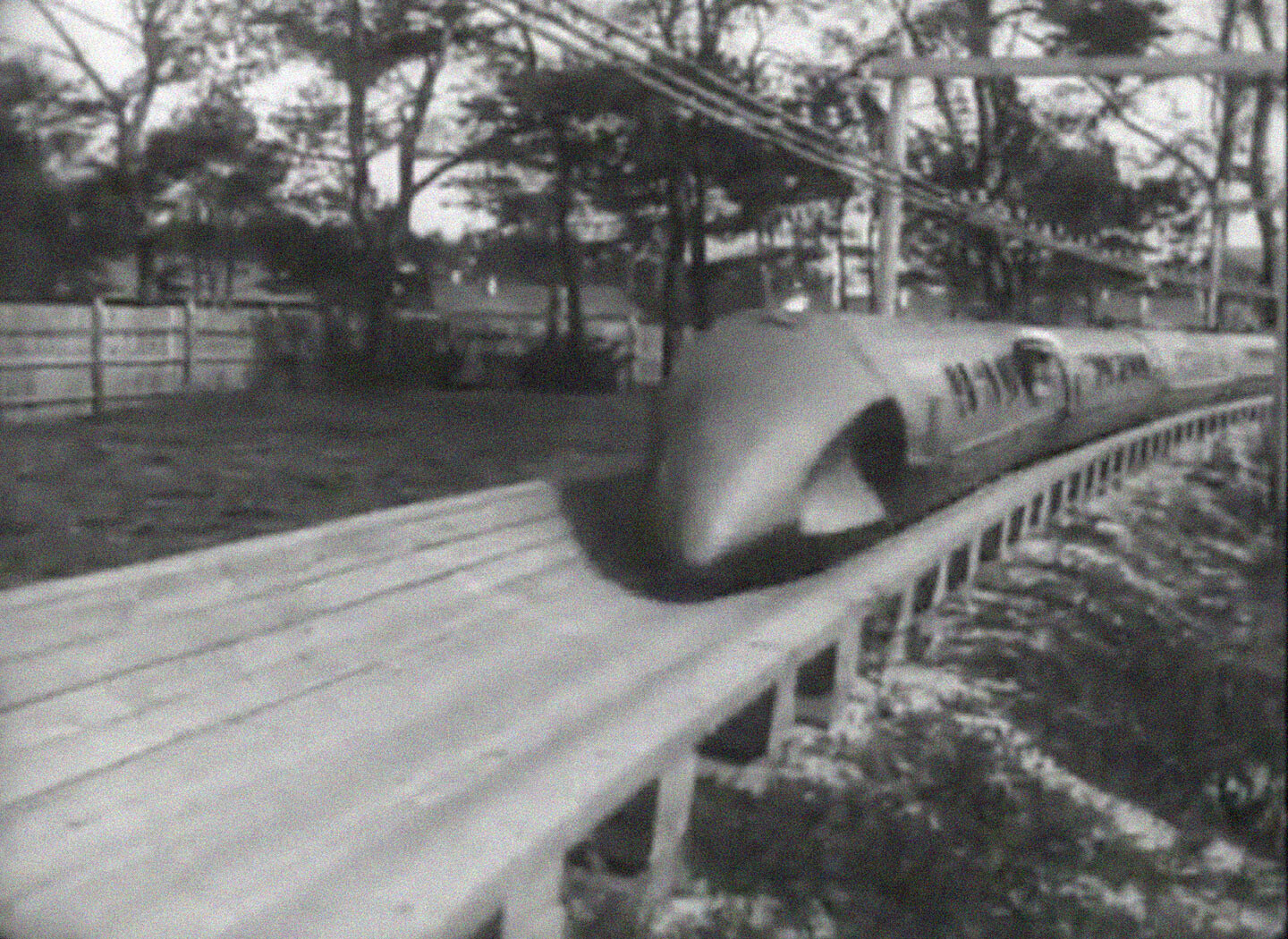

Nikolai Iarmol’chuk’s miniature spheremobile, with full-size passengers, from the newsreel Science and Technology (Nauka i tekhnika), 1934.
Evidently, The Cosmic Voyage was drawing not only on the same construction and design principles as these experimental technologies, but also on their logic of modeling. Featured in the same newsreel as Iarmol’chuk’s train was Vladimir and Ivan Nikitchenko’s pathbreaking method using scale models for the creation of special effects on screen, which was deployed in The Cosmic Voyage. The action of The Cosmic Voyage unfolds amidst a scale model of a futuristic Moscow landscape dominated by the unbuilt Palace of the Soviets. The Nikitchenko method of perspectival foreshortening is used to plot full-size human actors within this model landscape.
The most innovative feature of The Cosmic Voyage is its fluid, long-take cinematography, quite distinct from the Nikitchenko method, that naturalizes the model spacecraft. The spacecraft in The Cosmic Voyage are first presented in a remarkable long take of approximately one hundred seconds, where the camera tracks along and around the models. As it tracks, the camera catches other vehicles and even human figures in motion, making them part of a dynamic, polycentric world. The viewer is unlikely to mistake the model people and objects for the full-size, real world. The Cosmic Voyage simulates less a verisimiltudinous world than a verisimiltudinous gaze upon a world that is, for now, fantastic. That is to say, it operates not by animating the model itself, but by animating a subjectivity capable of viewing the reality it models. The Cosmic Voyage produces three-dimensional models not only of the things of the new world, but also of its subjects.
5. Model Art
I was reminded of the image from Andrei Platonov with which I began when I watched The Communist Revolution Was Caused by the Sun (2015), the second film in Anton Vidokle’s cosmist trilogy. Superficially, the film appears to continue the legacy of Soviet cybernetics, which drew on cosmist sources to produce a new theory of modeling, no longer as a material practice, but as virtual reality intended to replace the material world. However, Vidokle’s film also features airborne machinery that not only represents cosmic revolution, but which also is intended to produce it materially, following some vague logic and displaying quite dubious results. Vidokle’s model is deeply rooted in the history of such installations, from Tatlin to Francisco Infante-Arana’s Model of Space-Movement-Infinity from 1963 and beyond. Ilya Kabakov carefully follows the logic of the model in the visitor’s movement through the three sections of his Palace of Projects (2000): from improving the world and the self to the task of stimulating new projects. Here, cosmism remains primarily an operation of scale.
Olafur Eliasson has commented on the way in which we seem to be returning to the model as a way of working through our intractable current predicaments:
Previously models were conceived as rationalized stations on the way to a perfect object … Thus the model was merely an image, a representation of reality without being real itself. What we are witnessing is a shift in the traditional relationship between reality and representations. We no longer progress from model to reality, but from model to model while acknowledging that both models are, in fact, real … Models have become co-producers of reality.17
In light of the foregoing, this sounds as if socialist realism has conquered contemporary art. Could this be a good thing?
One thing that distinguishes our contemporary model-making from that of socialist realism is its irony. Kabakov in particular foregrounds the model’s history of failure at keeping communism aloft. Project 52 in the Palace of Projects, by V. Stozharov, a retiree from Leningrad, proposes the digging of canals across the entire country, which directly recalls the Soviet abuse of convict labor on canal projects.18 These projects all represent impossible, self-destructive desires, and Kabakov lampoons any world in which they are held seriously—primarily, of course, the world of Russian and Soviet cosmist Marxism—and he ridicules the frankly silly idea that such impossible desires can be achieved by being modeled as miniaturized material objects.
However, when Kabakov provides a material installation of these desires—a model of their fulfillment and their failure—and when Vidokle documents the puzzlement of the residents of Karaganda, Kazakhstan over his experimental technology, the animating desire is allowed to persist despite its patent impossibility. By installing these models and documenting their tentative operation, Vidokle has provided us with a mode, if not of realizing them as reality, then at least of inhabiting them briefly, experiencing materially the space of the impossible. That is, I want to say, these experiments in revolutionary irony might not model a viable formation of the Anthropocene, but they might help to model us as subjects of what will succeed it. In their wistful embrace of models, these ironic cosmists breathe soul back into the contemporary art machine.
Andrei Platonov, Fabrika literatury (Moscow: Vremia, 2011), 136.
Karl Marx, Capital, vol. 1, chap. 7, republished in The Marx-Engels Reader, ed. Robert C. Tucker, 2nd ed. (New York: W. W. Norton, 1978), 344.
N. I. Bukharin, “Sotstialisticheskaia rekonstruktsiia i bor’ba za tekhniku. O technicheskoi propagande i ee organizatsii,” in Problemy teorii i praktiki sotsializma (Moscow: Politizdat, 1989), 312. Further references to this edition are given parenthetically in the text. Cf. also: N. Bukharin, “V TsK VKP(b). Dokladnaia zapiska o tekhnicheskoi propagande i ee organizatsii,” Pravda 8 (August 1931): 2.
Cf. Robert Bird, “The Poetics of Peat in Soviet Literary and Visual Culture,” Slavic Review 70, no. 3 (Fall 2011): 591–614.
Stalin i Kaganovich: Perepiska, 1931–36 (Moscow: ROSSPEN, 2001), 72; The Stalin-Kaganovich Correspondence, 1931–36, eds. R. W. Davies et al. (New Haven: Yale University Press, 2003), 69.
Stalin i Kaganovich: Perepiska, 75; The Stalin-Kaganovich Correspondence, 42.
Daniel Tiffany, Toy Medium: Materialism and Modern Lyric (Berkeley: University of California Press, 2000), 3.
Marx-Engels Reader, ed. Tucker, 344–45.
Lev Vygotskii, “Soznanie kak problema psikhologii povedeniia,” in Psikhologiia i marksizm: Sbornik statei sotrudnikov Moskovskogo gosudarstvennogo institute eksperimental’noi psikhologii, ed. K. N. Kornilov (Leningrad: Gosudarstvennoe izdatel’stvo, 1925), 183.
Ibid., 181.
N. F. Chuzhak, “Pod znakom zhiznestroeniia (Opyt osoznaniia iskusstva dnia),” LEF 1 (1923): 35.
N. F. Chuzhak, “K zadacham dnia (stat’ia diskussionnaia),” LEF 2 (1923): 146.
D. Greitser and V. Bibikov, Iskusstvo modelirovaniia (Moscow, Leningrad: KOIZ, 1932), 5.
See, for instance, Pravda 31 (July 1936): 1.
Kornelii Zelinskii, “My vybiraem budushchee,” Sovetskoe kino 1–2 (1934), 88.
Nashi dostizheniia 7 (1933) →.
Olafur Eliasson, “Models Are Real,” 306090 11 (2007): 19.
Ilya Kabakov, The Palace of Projects (Düsseldorf: Richter, 2001).
